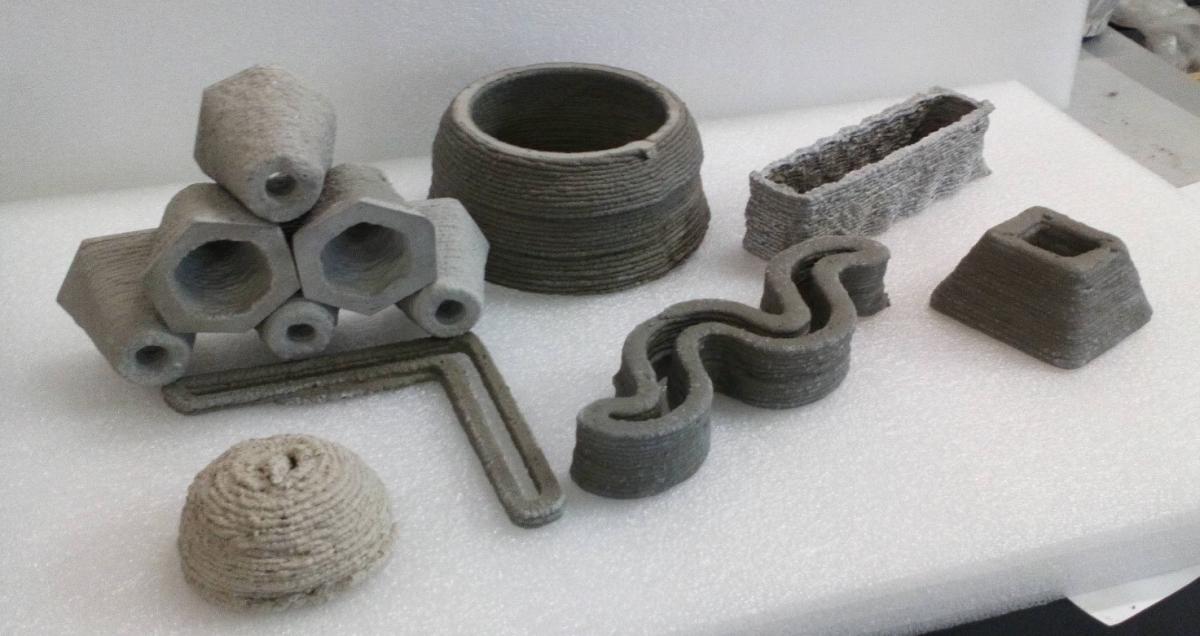Revolution of circular economy?
MERVI: The basis of the Urban Infra Revolution (UIR) project is to develop more sustainable and ecological materials from local side streams to future building. The goal is to manufacture material that can be, vernacularly, 3D printed to its final form, so molds are no longer needed. At the same time, concerning the printing technique, a certain rheology and runniness is expected of the material, so the final product has a smooth and aesthetic surface. The material now exists, and it's called "geposite".
Revolution of construction material or building?
HEIKKI: The technique and materials developed will inevitably change the design language, building practices as well as the inner and outer essence of buildings. All materials and manufacturing techniques have their own handprint from the point of view of the designer. If the designer, or in this case the architect, designs the product against this natural handprint, the result is often more expensive and somehow contrived. For example, plastics were for a long time used to imitate products made from leather, amber and wood, and now when plastics can be designed in their own terms, products are more natural, honest and significantly more affordable.
For example sharp edges would be, for the printing technique in development, imitations of mined rock or elemental substances. Also keeping in mind cleaning, the edges belong on a list of aspects in need of critical evaluation. Similarly different layer techniques such as plasterboard-caulk-fabric wallpaper-wall surfaces, parquet, clinker, roof panel, multiple substance and layered solutions feel very unfamiliar, when geposite itself can at its best execute the demands of both the outside and inside, as well as thermal insulation and damp spaces.
Physics, chemistry, design or environmental technology?
MERVI: On the UIR project, the recipe of the material's creation was heavily relied on the knowledge of chemistry. We had to find those recycled raw materials that had chemical components that fit the chemical reactions of geposite. On the other hand, the chemical composition forced us to give up the use of some sources of raw materials as binding agents altogether. Certain challenges concerning raw materials that originate from side streams had to be tackled with chemical reactions as well. However, by utilizing recycled raw materials, the significant environmental advantage achieved makes this product development profitable.
Physics and environmental technology is in this development represented by how the printing technique can be utilized in producing functional substances. We can for example print a cellular, three-dimensional layer of insulation that binds air between two smooth wall surfaces at the same time. Strength can be implemented with fibers that are currently being developed to use among the printed mass.
HEIKKI: Strength is important in building, and it cannot be bargained with! Now when we talk about stone houses, we most often mean houses made with reinforced concrete. Concrete is actually the composite of cement, sand, water and steel. By replacing steel with cellulose or other natural fibers, the structure can be expected to be just as strong, yet warmer, lighter, more breathable and very easily recyclable. In addition, cellulose, basalt and certain glass fibers don't rust, so they don't have to be protected with a five centimeter layer of plaster. Also from an environmental point of view, the role of steel in concrete building is often forgotten by experts as well: It represents about two thirds of building costs, raises carbon footprints and is in recycling a separately collected item. As such, steel does recycle around the world commendably!
According to my vision, the new geopolymer composite strengthened with natural fibers combined with the printing technique combines the best qualities of wood and rock. Geposite can after use be either returned to the process for recycled structures or used safely to enhance the ground. Circular economy at its best?
Futurology or near future?
MERVI: Geopolymer and mineral aggregate mixtures that utilize it as a binding agent are already known and deemed appropriate: their history goes all the way back to the 70s. The materials just have taken their time before landing to Finland.
Similarly also the utilization of side stream materials in the manufacturing industry has taken its time. Some have used them for a long time though: Plastic side streams are utilized in Durat® solid surface materials and porcelain mixtures are used in Tulikivi furnaces. Yet side streams are not yet competed over. This year that has definitely increased, and we will for sure see more products containing recycled materials in the near future, provided that productization is succesfully taken into consideration in legislation.
HEIKKI: Construction is full of different norms, rules and standards that at their core secure a homogenous, user friendly and safe building. Many think that this "jungle of rules" has become a force that slows down the development of the field. For example CLT (Cross Laminated Timber) was developed to its current condition somewhere in the mid 90s and only now is it arriving to the markets.
Technically, printed geopolymer composite materials strengthened with fibers could be utilized in the construction industry in a few years, but proving that they fit into the norms as well as coming up with new norms and norms that standardize the field will probably take the same amount of time than it did for CLT, meaning 15-25 years.
Before that, probably many applications that are far more demanding will be seen in markets, such as grills, crucibles, flue gas scrubbers, street furniture, different poles and pylons as well as firewalls that isolate fire and sound of the automotive industry, and I wouldn't find ballistic structures such as special structures concerning nuclear safety and space technology too demanding either.
JUHA: There are plenty of norms, sometimes even frustratingly many, and the human mind cannot always fathom everything. In construction I kind of understand the need. Think about aluminum cement and balconies that were made with it that have since collapsed. Nowadays that substance could perhaps be used in more supporting structures, but if the risk exists, it must be acknowledged.
Looking at the near future, less regulated products mentioned by Heikki should be tested, so a long-term testing could be initiated. If and when successes were made, solutions that utilize geopolymers would raise more interest elsewhere as well.
As a former ceramic chemist I am drawn to those fiery products. A classic geopolymer can withstand more than a thousand degrees of heat, similarly to feldspars that are used as raw materials in porcelain masses. Nevertheless, porcelain's heat resistence is easily a couple hundred degrees more compared to feldspar. – What, why doesn't it melt earlier? Well because it for the most part consists of other fillers, that determine the termic duration. These can always be tuned a little bit, if there's a unlimited amount to choose from.
Now to get back to the revolution of urban building in the UIR project...
JUHA: At the moment the project is looking pretty good. Usable raw materials have been learned to recognize as well as what chemistry they obey and to what extend. Also the chemistry that makes them angry is now detected, which is actually really important.
Apilan pienellä printterillä on saatu tulostettua useampaakin testimuotoa. Alkuaika meni opetellessa ja ylöspäin skaalatessakin on ollut pientä säätöä. Lujuudet on tulosteissa olleet samoilla ruippeilla valujen kanssa eli puristuslujuuden suhteen puhutaan rakennebetonin numeroista, taivutuslujuuden suhteen betonia paremmista. Lienee siis geopolymeeri sitkeämpää kuin sementti.
Multiple test structures have been printed with Apila's small printer. In the beginning a lot of learning was required and upside down scaling has acquired some small adjustments. Strength in the prints have been at the same level as with moldings, so concerning compressions resistance we are talking about the same numbers as in construction concrete and concerning flexular strength better than concrete. Geopolymer thus must be more resilient than cement.
Actually, with a pretty good conscience I will put a picture of the structures below. This will be great someday.

HEIKKI: Because I'm actually a "plastics man", I have a hard time detaching from the world of molds and modularity. The hardest part was and still is to understand that the goal of the project of printing a moldable geopolymer composite doesn't mean "changing from cement to geopolymer", but it rather creates a real chance to proceed from "environmental art" based on manual labor to semi-industrial processes. Even in a way, that individual solutions don't necessary lift up the price of the end product. If this is not about a revolution, it is at least about mitigating "hand" and "carbon footprints" radically...
MERVI: This has been a spectacular project and in our hands we have as spectacular material and techinque. Future scenarios indicate that 3D printing will be a significant part of the manufacturing industry in the future. It is important to remember however, that the future in question is not "either - or", but we need both traditional and new technique and materials. For example in building: a wooden house will always have a foundation made of crushed stone aggregate while a stone house will always include wood.
The most important aspect of the project for me is that we are able to utilize those local material streams that would otherwise end up as piles, while at the same time elsewhere natural substances are dug up for use. A material-wise use of natural resources is what circular economy should strive for in every way.

Comments